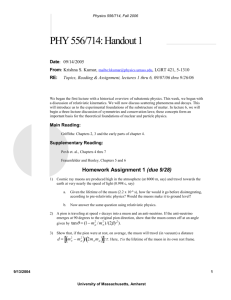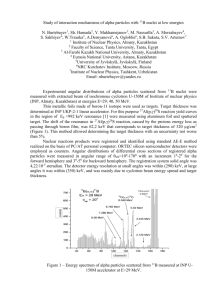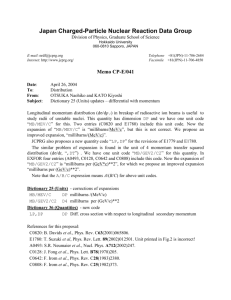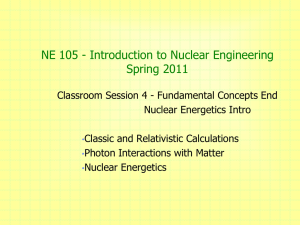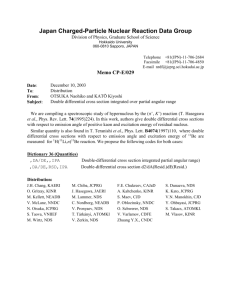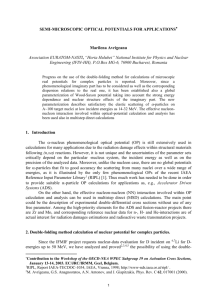AS Demyanova et al., Int. J. Modern. Phys. E 20, No 4, 915 (2011)
advertisement
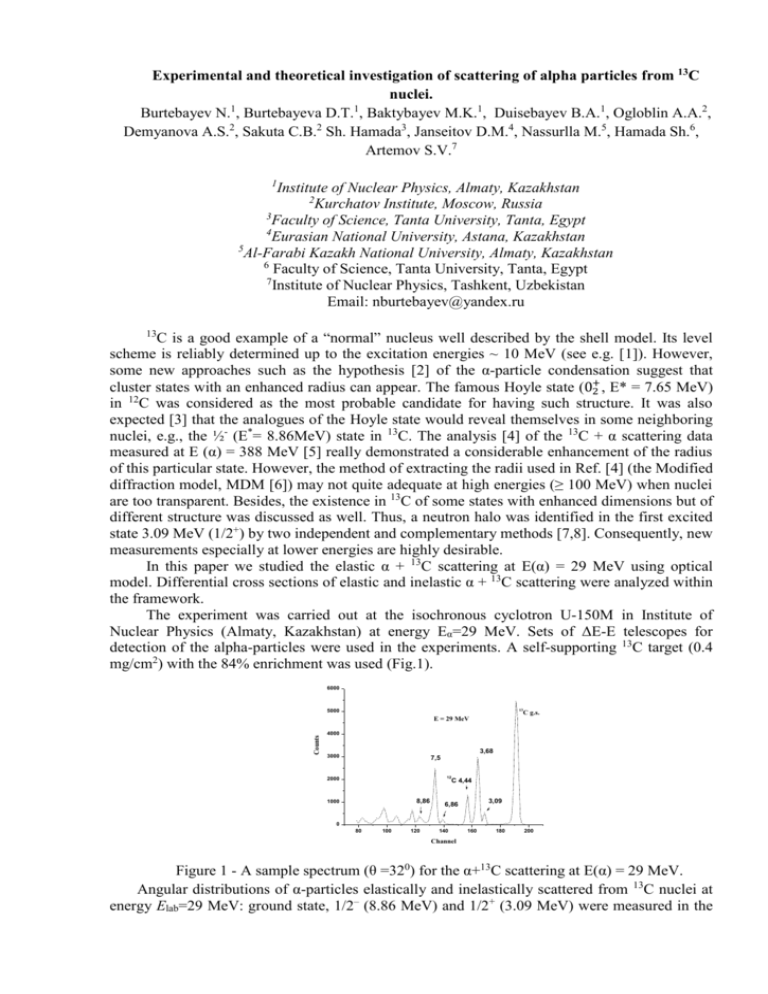
Experimental and theoretical investigation of scattering of alpha particles from 13C nuclei. 1 1 Burtebayev N. , Burtebayeva D.T. , Baktybayev M.K.1, Duisebayev B.A.1, Ogloblin A.A.2, Demyanova A.S.2, Sakuta C.B.2 Sh. Hamada3, Janseitov D.M.4, Nassurlla M.5, Hamada Sh.6, Artemov S.V.7 1 Institute of Nuclear Physics, Almaty, Kazakhstan 2 Kurchatov Institute, Moscow, Russia 3 Faculty of Science, Tanta University, Tanta, Egypt 4 Eurasian National University, Astana, Kazakhstan 5 Al-Farabi Kazakh National University, Almaty, Kazakhstan 6 Faculty of Science, Tanta University, Tanta, Egypt 7 Institute of Nuclear Physics, Tashkent, Uzbekistan Email: nburtebayev@yandex.ru C is a good example of a “normal” nucleus well described by the shell model. Its level scheme is reliably determined up to the excitation energies ~ 10 MeV (see e.g. [1]). However, some new approaches such as the hypothesis [2] of the α-particle condensation suggest that cluster states with an enhanced radius can appear. The famous Hoyle state (0+ 2 , E* = 7.65 MeV) 12 in C was considered as the most probable candidate for having such structure. It was also expected [3] that the analogues of the Hoyle state would reveal themselves in some neighboring nuclei, e.g., the ½- (E*= 8.86MeV) state in 13C. The analysis [4] of the 13C + α scattering data measured at E (α) = 388 MeV [5] really demonstrated a considerable enhancement of the radius of this particular state. However, the method of extracting the radii used in Ref. [4] (the Modified diffraction model, MDM [6]) may not quite adequate at high energies (≥ 100 MeV) when nuclei are too transparent. Besides, the existence in 13C of some states with enhanced dimensions but of different structure was discussed as well. Thus, a neutron halo was identified in the first excited state 3.09 MeV (1/2+) by two independent and complementary methods [7,8]. Consequently, new measurements especially at lower energies are highly desirable. In this paper we studied the elastic α + 13C scattering at E(α) = 29 MeV using optical model. Differential cross sections of elastic and inelastic α + 13C scattering were analyzed within the framework. The experiment was carried out at the isochronous cyclotron U-150M in Institute of Nuclear Physics (Almaty, Kazakhstan) at energy Eα=29 MeV. Sets of ΔE-E telescopes for detection of the alpha-particles were used in the experiments. A self-supporting 13C target (0.4 mg/cm2) with the 84% enrichment was used (Fig.1). 13 6000 13 5000 Counts Е = 29 MeV С g.s. 4000 3,68 3000 7,5 12 2000 8,86 1000 C 4,44 3,09 6,86 0 80 100 120 140 160 180 200 Channel Figure 1 - A sample spectrum (θ =320) for the α+13C scattering at E(α) = 29 MeV. Angular distributions of α-particles elastically and inelastically scattered from 13C nuclei at energy Elab=29 MeV: ground state, 1/2– (8.86 MeV) and 1/2+ (3.09 MeV) were measured in the d/d [mb/sr] angular range θlab. = 10o – 80o with increments of 1o – 2o. Energy resolution of the detector at small angles is ~ 290 keV, and at large angles is ~ 350 keV. The experimental data at this energy showed a well-developed diffraction scattering pattern. 10 5 10 4 10 3 10 2 10 1 10 0 4 13 He+ C, E=29 MeV -1 10 -2 10 -3 10 -4 10 -5 10 0 20 40 60 80 100 120 140 160 180 200 CM Figure 2 - Differential cross sections for elastic scattering of alpha particles on 13C at energies E = 29 MeV. Solid red and black lines are the calculations within the framework of optical model, solid blue line is calculations using double folding model. In addition to our experimental data at Elab=29 MeV, α+13C elastic scattering was analyzed at different energies from literature; 65 MeV [9], 54.1 and 48.7 MeV [10], 35 MeV [11] and 26.6 MeV [12]. The theoretical predictions were performed using both empirical Woods-Saxon (2 sets of potentials) and double folding optical model potentials (Fig.2). The comparison between the experimental data and the theoretical predictions is fairly good overall the whole angular range. We managed from obtaining physically reasonable parameters for the interaction potentials. Analysis of data on inelastic scattering (excited states of 3.09 and 8.86 MeV) is planned to done with the use of the obtained parameters of optical potentials in the following papers. This work is supported by grant of MES of the Republic of Kazakhstan # 0601 GF. References [1] W. von Oertzen, M. Freer, Y. Kanada-En’yo, Phys. Rep. 432, 43 (2006) [2] A. Tohsaki, et al., Phys. Rev. Lett. 87,192501 (2001); P. Schuck et al., Nucl.Phys. А738, 94 (2004) [3] M. Milin and W. von Oertzen, Eur. Phys. J. A 14, 295 (2002) [4] A.S. Demyanova et al., Int. J. Modern. Phys. E 20, No 4, 915 (2011) [5] T. Kawabata et al., Journal of Physics: Conference Series, 111, 012013 (2008); Journal of Modern Physics E 17, 2071 (2008) [6] A.N. Danilov et al., Phys. Rev. C 80, 054603 (2009) [7] Z.H. Liu et al., Phys. Rev. C64, 034312 (2001) [8] A.A.Ogloblin, et al., Phys. Rev. C 84, 054601 (2011) [9] A.S.Demyanova et al. // INPC 2013: 2-7 June 2013, Firenze, Italy, NS 051 [10] H.Abele. et al. // Zeitschrift fur Physik, Atomic nuclei, V.326, p. 373-381, 1987 [11] С.В.Артемов, Г.Ким, Г.А.Радюк // Изв. РАН, сер.физ, т.65, № 11, стр. 1579-1581, 2001 [12] Б.И.Кузнецов, И.П.Чернов // Ядерная физика, т.20, вып.4, стр. 632-638, 1974

